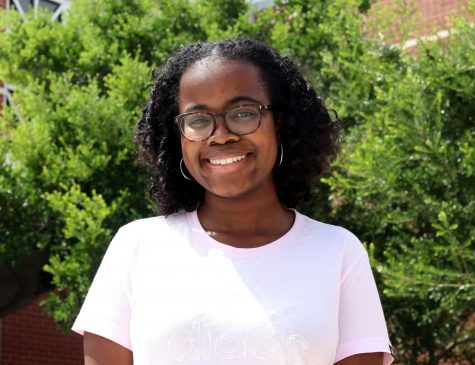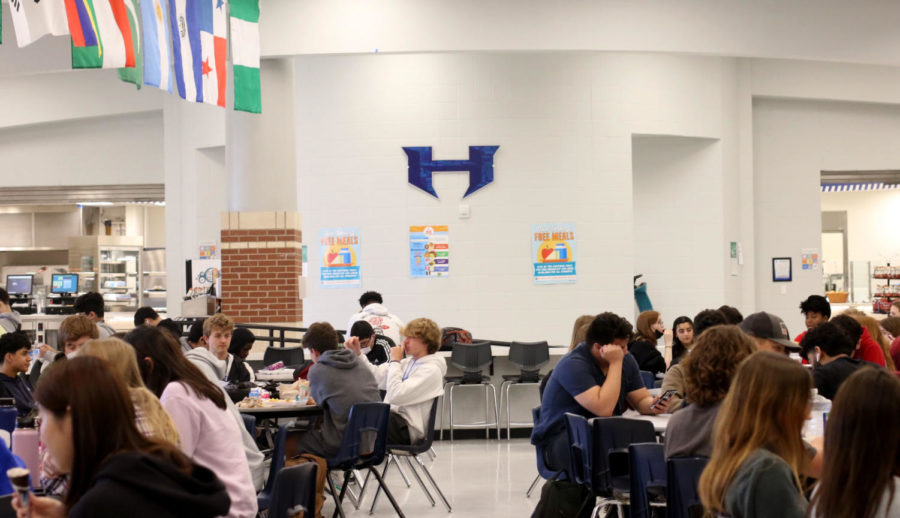Staff Editorial: Block lunch is needed now more than ever
Students eat in the cafeteria during C lunch on March 31. Since the 2020-21 school year, the advisory schedule has been exclusively used where students are assigned A, B, C or D lunch based on their third period teachers.
Two years after the initial school closures due to COVID-19, school for Hebron students has returned to normalcy in many ways except one: block lunch. Beginning in 2014, block lunch was an hour-long period split into “A” lunch and “B” lunch. Block lunch largely allowed students to make their own schedule, dividing the block between attending tutorials or club meetings and eating lunch when and where they chose.. Block lunch was divisive, however, as fights would occasionally occur during that time, and in the 2019-20 school year, a block lunch committee of teachers was formed to decide on the continuation or cessation of block lunch. That committee never made a publicized decision. Block lunch was naturally and quietly phased out for the 2020-21 school year as it was COVID-19 concern.
Almost two years later, it is time to resume block lunch because it was overwhelmingly beneficial to student academic, social and emotional well-being and is needed now more than ever.
Block lunch would benefit students who are still struggling to adapt to normal school life after online learning. It’s understandable that students have been struggling to readjust to structured learning. The average attendance rate for the 2021-22 school year has been 94%, whereas attendance rested at 96% pre-COVID-19. Block lunch would remedy some issues for those struggling to adjust as it offers a longer break from academic classes during which students can mentally recharge, ultimately making school a more enjoyable place. Additionally, the current schedule of A, B, C and D lunches divides the student body, impedes connection and could cause students to lose touch with their friends if they didn’t win the lottery of having the same lunch.
For students who are new or struggling to find their place, they need school to feel small, not big. Clubs during block lunch allowed students to delve into what they enjoy. All students could attend clubs as they were conveniently worked into the school day. This year, Fridays were designated as club days, but pep rallies and a spike in COVID-19 cases in January limited the school to fewer than 10 club days so far. Even when there were Friday club days, students could only attend one club meeting on that day. Clubs give students the chance to meet and connect with people who share their hobbies, interests, culture or religion and improve mental wellbeing through the connectivity they provide.
The right to block lunch was always precarious due to behavioral issues that would occur during that time. However, student behavior has already been bad this year. From the start of the year toward the end of October, discipline infractions totaled over 660 among 10th, 11th and 12th graders. There is nothing to lose in the behavioral issues category by the continuation of block lunch. If anything, the breathing time and chance for healthy coping via clubs or open gym could improve student behavior.
The potential spread of COVID-19 is admittedly a downside of block lunch. While block lunch entails more students compactly gathered, so do pep rallies and school dances, which have continued this year. Reimplementing block lunch does not have to come at the expense of advisory as well. A few days a week could still be spent in advisory where students receive important information and state-mandated lessons. While advisory should continue, not every advisory day is spent on lessons, so it should not be daily.
Block lunch should be continued even if it is just for a few days a week to improve student connection and well-being. Students and parents should convey their desire for the return of block lunch to administration.

Senior Katherine Parker is the managing editor and this is her second year on staff. She loves journaling and spending time outdoors. In her free time,...



